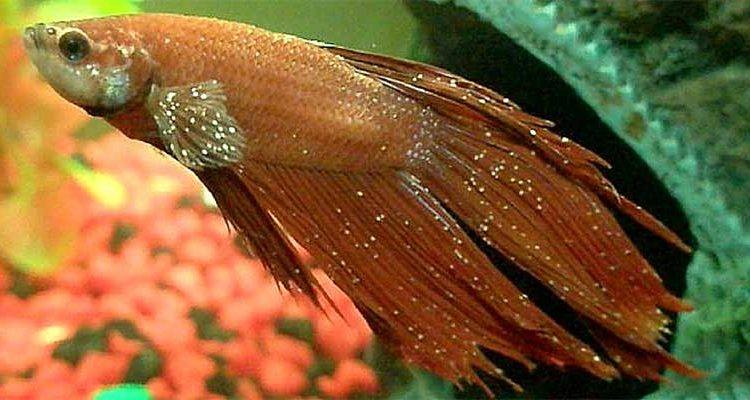Ich (Freshwater White Spot Disease) looks like tiny salt crystals growing on your fish. It’s caused by a protozoan parasite that will feed on your fish then drop a capsule into the tank that can create over 1000 more protozoan, quickly overwhelming the tank.
This disease should be considered an emergency, and treatment should begin immediately. Even if treated early, fish do not have a very good chance of survival.
Treatment
Bring the salt level up to 1% (add 10 grams of salt per liter). Heat the tank up to 86 Fahrenheit (30 Celsius). Do a 30% water change daily and try to vacuum up the waste protozoans from the bottom of the tank while doing so1.
Fish have about a 50% survival rate with this treatment.
Do not add salt to a tank with a zeolite filter. Salt will kill snails and some live plants. If this is you, use a hospital tank of aquarium water to treat your fish and quarantine your live plants and snails.
Myth 1: “Most of the time people don’t really have an ich infection but have epistylis and ich treatment will make epistylis worse.”
Truth 1: Ich infections are more than twice as likely to occur than an epistylis infection2. Additionally, the salt and heat treatment is more effective at treating epistylis than it is ich. Yes, they have the same treatment, but you have a better chance of success.
Myth 2: “I used product X instead of salt, and it cured it.”
Truth 2: No you didn’t. Most over-the-counter medicines contain Malachite Green, Methylene Blue, or Formalin. They have been shown to have a 9% chance of success, which is only a 1% better chance than doing nothing (8%). Many antibiotic medicines contain up to 99% salt by weight, with only 1% of the active ingredient being an actual antibiotic. So it’s the salt that cured it, not the antibiotic.
Myth 3: “You need to use aquarium salt.”
Truth 3: No you don’t. If you don’t have aquarium salt use regular kitchen salt. Even using iodized kitchen salt will be better than waiting until you can Amazon some aquarium salt.
Myth 4: “Salt is bad for scaleless fish.”
Truth 4: No it’s not, and scaleless fish are more susceptible to dying from ich2.
Myth 5: “My fish has Ich. Ich always lives in an aquarium and waits until your fish’s immune system is weak.”
Truth 5: Yeah, but does it really? Ich does not magically appear. It is less likely to occur with our solitary betta fish because we’re not running a community tank. It comes from adding live plants, snails, and other things from the pet store in general. You may have ich if you’ve added something to your tank recently, or if your fish is new. Otherwise, it’s probably not ich.
Myth 6: “Heat can make ich infections worse.”
Truth 6: Heat will speed up the life cycle of ich. Yes, this would mean that they would be reproducing more rapidly. However, the reason heat is used is because the salt only attacks the parasite at a certain place in its lifecycle, so it’s important to make sure that the salt treatment occurs at this point1. If we heat the tank, the ich will actually die faster. If we heat the tank without the salt treatment, then yes, it would make it worse.
Myth 7: “Ich doesn’t form on the eye, while epistylis does.”
Truth 7: Ich commonly infects the cornea of the eye.3 Epistylis can also cover the cornea, but it is rare.4 If the substance is more transparent than opaque and you see it in places other than the fish, it is more likely to be epistylis.
Myth 8: “If the spots are irregularly shapes and sizes it’s epistylis and not ich.”
Truth 9: This hasn’t been true since Neoichthyophthirius schlotfeldti was identified in 1997. The new ich reproduces under the skin of the fish instead of dropping sacs into the tank. This results in more irregularly sized and shaped spots on the fish.5
Literature Cited
1M. A. A. Mamun, S. Nasren, K. H. Srinivasa, S. S. Rathore, P. B. Abhiman & K. Rakesh (2020) Heavy infection of Ichthyophthirius multifiliis in striped catfish (Pangasianodon hypophthalmus, Sauvage 1878) and its treatment trial by different therapeutic agents in a control environment, Journal of Applied Aquaculture, 32:1, 81-93, DOI: 10.1080/10454438.2019.1610541
2 Noga, E. J. (2010). Fish disease: Diagnosis and treatment. Ames, Iowa: Wiley-Blackwell. P. (pp. 131, 155)
3 Buchmann, K., Lindenstrøm, T., & Sigh, J. (1999). Partial cross protection against Ichthyophthirius multifiliis in Gyrodactylus derjavini immunized rainbow trout. Journal of Helminthology, 73(3), 189-195.
4 de Pádua, S. B., Ishikawa, M. M., Kasai, R. Y. D., Jerônimo, G. T., & Carrijo-Mauad, J. R. (2012). Parasitic infestations in hybrid surubim catfish fry (Pseudoplatystoma reticulatum x P. corruscans). Embrapa Agropecuária Oeste-Artigo em periódico indexado (ALICE).
5 Bauer, O. N., & Iunchis, O. N. (2001). A new genus of parasitic ciliata from tropical fishes. Parazitologiia, 35(2), 142-144.
